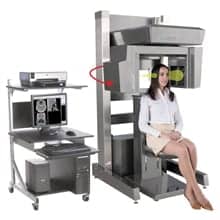
|
Some of the most delicate, high-contrast structures in the human body are located in the skull, making it difficult to assess morphology and pathological processes. MiniCAT? specialty low-dose point-of-care volume CT from Xoran Technologies Inc, Ann Arbor, Mich, is specifically designed for head and neck imaging tasks that are critically dependent on spatial resolution. Creating true isotropic voxels at a significantly higher resolution than scans taken with most full-body CT scanners, MiniCAT? is ideal for imaging the temporal bones, skull base, and sinuses. MiniCAT? features submillimeter spatial resolution to better visualize small anatomic structures, and creates versatile images of temporal bone for digital manipulation, including an oblique tool for real-time multiplanar reconstructions along a user-defined arbitrary plane (for semicircular canal, TMJ, and other oblique visualization needs).
With built-in “as low as reasonably achievable” (ALARA) dose protocols, MiniCAT? accurately images the skull and sinuses while minimizing patient exposure to radiation; an open, upright design allows the patient to sit comfortably during scans without claustrophobia. The scanner features network capabilities, making it easy to transmit images for teleradiology services or image-guided surgery, and data can be saved in multiple formats. After scanning, MiniCAT? instantly displays digitally versatile CT images on a computer monitor for diagnosis, and because the system is Web-enabled, radiologists can view images anywhere with Internet access.
The Spec Sheet
- Standard imaging protocols reconstruct 0.3 mm isotropic voxels, with instant digital views of axial, coronal, and sagittal planes. Customized protocols can be created to take the resolutions to as low as 0.2 mm.
- Scans take 40 seconds for adults and 20 seconds for children.
- Data can be saved on a CD, DVD, USB jump drive, or file server.
- Offers industry standard DICOM network capabilities.
- Voxel size is 0.3 mm x 0.3 mm x 0.3 mm.
- ALARA patient dose is between 0.04 and 0.14 mSv.
The Visible Difference
Easy to use—for all parties involved—MiniCAT? has an open, upright design that makes it comfortable for patients, with short scan times enhancing the simplicity. Rapid scan times and easy digital transmission to workstations enhance workflow; and MiniCAT? is operated with a Windows-based PC and features user-friendly software. MiniCAT? is even easy on a facility—it weighs less than 450 pounds, fits through standard door frames, plugs into an ordinary electrical outlet, and does not require an additional room cooling system.





